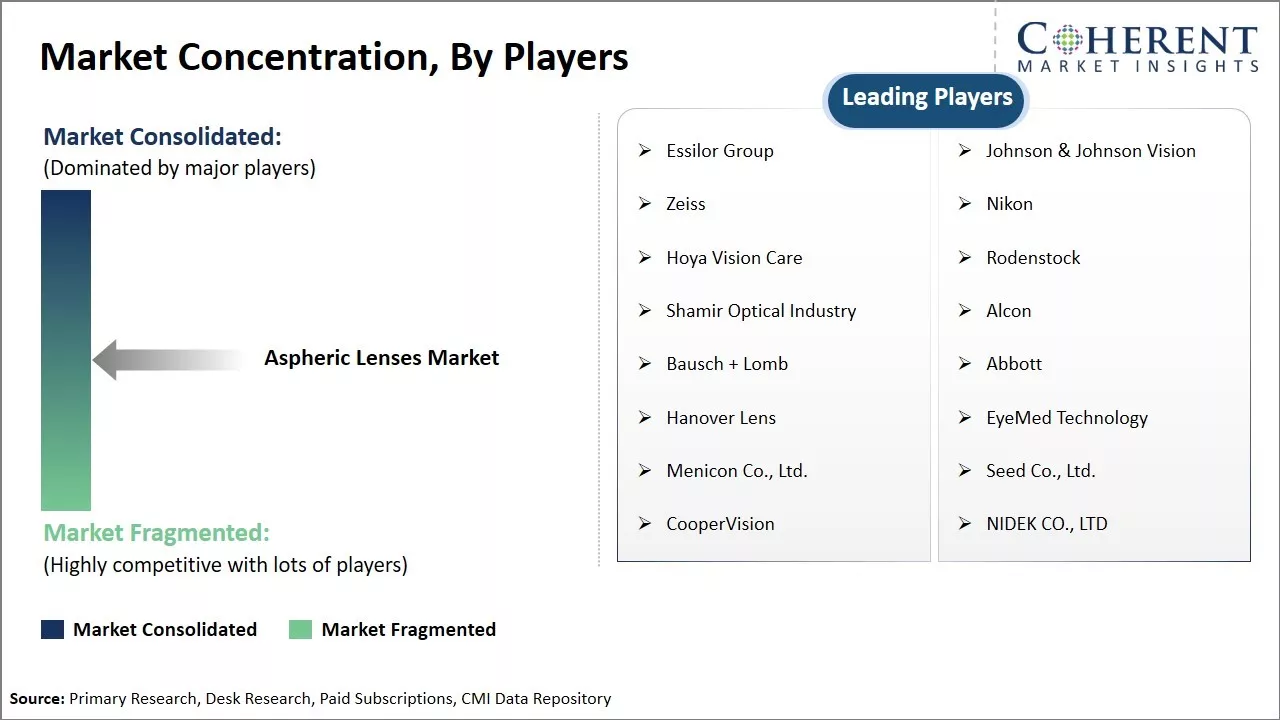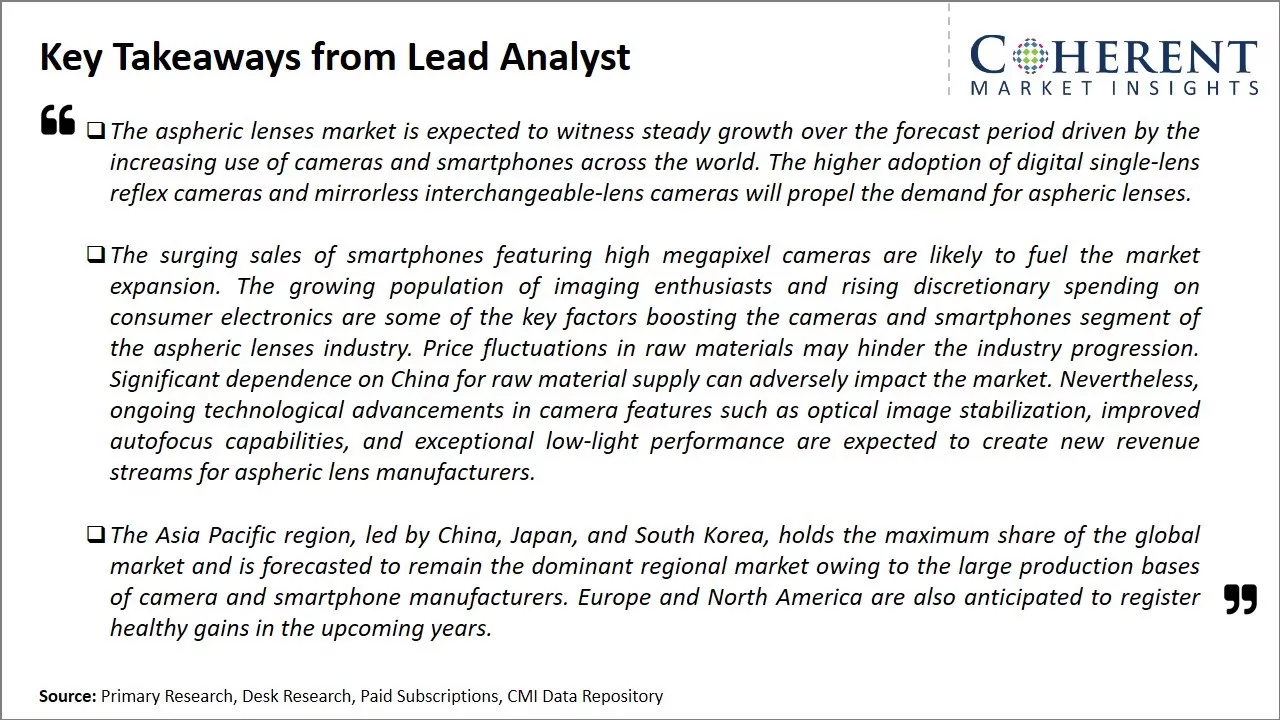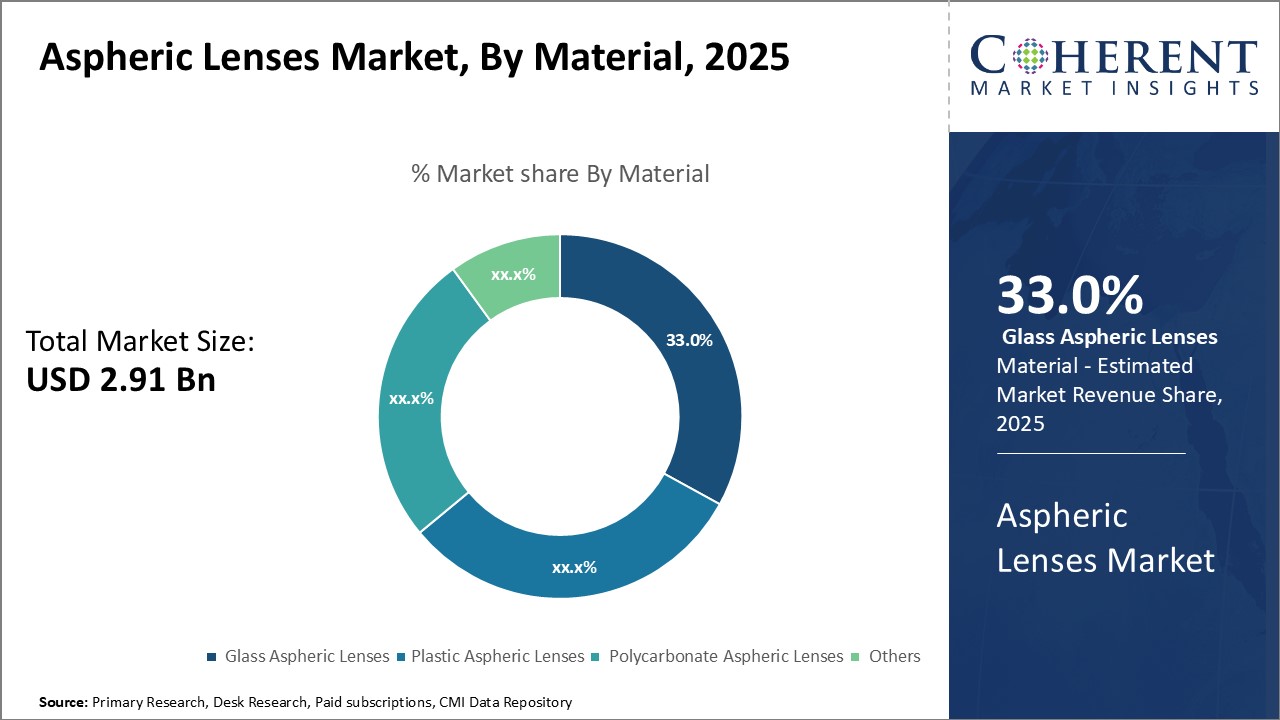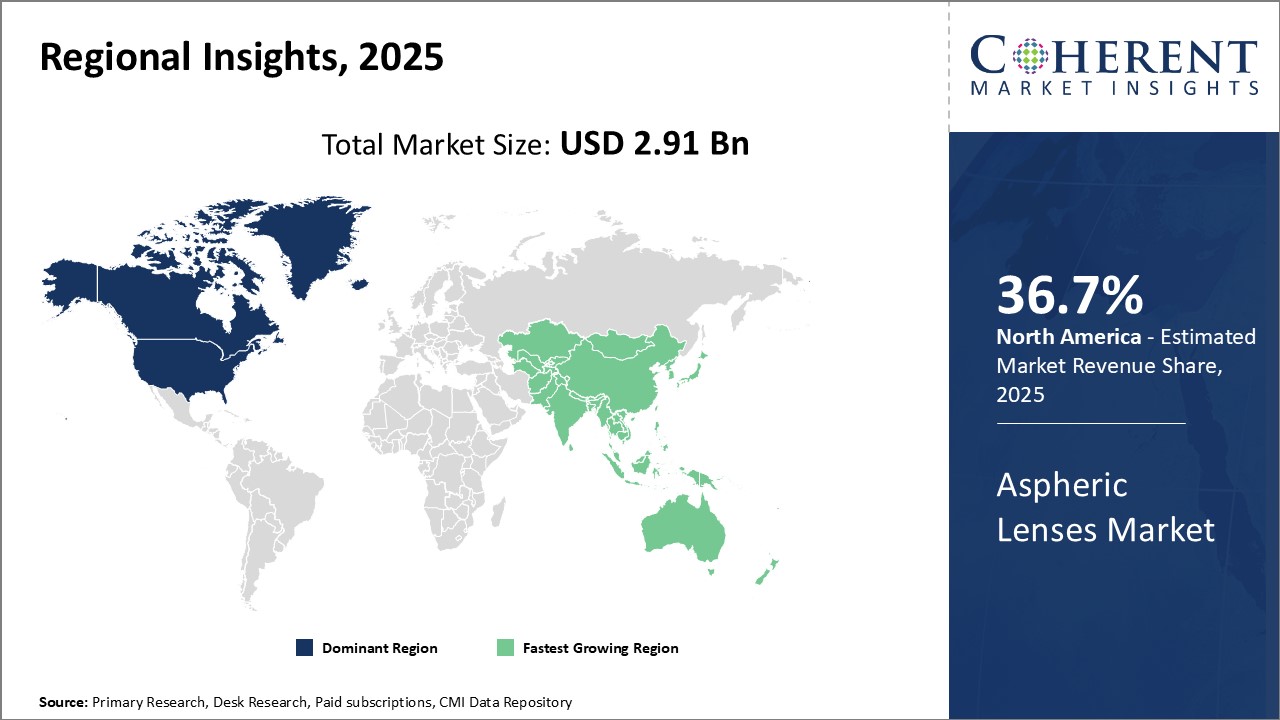Aspheric Lenses Market Size and Trends
The aspheric lenses market is estimated to be valued at USD 2.91 Bn in 2025 and is expected to reach USD 4.52 Bn by 2032, growing at a compound annual growth rate (CAGR) of 6.5% from 2025 to 2032.

Discover market dynamics shaping the industry: Download Free Sample
The increasing demand for aspheric lenses from various end-use industries such as telescopes, microscopes, cameras, and ophthalmic is driving the market size. Rapid technological advancements in lens designing and production is also supporting the growth of this market.
The aspheric lenses market trend shows growing prominence of aspherical optical lens technology. Aspheric lenses are able to correct glass spherical aberration with their non-spherical surfaces and asymmetrical profiles. This allows them to have wider viewing angles and reduce distortions. Manufacturers are extensively deploying aspheric lenses in cameras, projection displays, optics equipment, and other consumer electronics. In the healthcare industry, aspheric contact lenses are gaining traction due to their enhanced comfort and clear vision. The surging use of aspheric lenses across industrial, medical, and consumer electronics is expected to drive the market growth over the forecast period
Rising technological advancements
The aspheric lenses market has been witnessing significant growth over the past few years owing to the rising demand from various industries such as electronics, telecommunication, and healthcare. There has been a continual advancement in the field of optics which has increased the application of aspheric lenses in different devices such as smartphones, DSLR cameras, medical equipment, and more. The miniaturization of technological devices has imposed a need for compact optics with high precision. Aspheric lenses help meet this need due to their capability to reduce the spherical aberration in an optical system. Their unconventional shape allows optimizing different optical path lengths to produce sharper images.
Aspheric lenses find wide application in medical equipment such as surgical microscopes, endoscopes, and ophthalmic lenses among others. Their precise optical properties allow conducting intricate surgeries and treatments with higher accuracy. With technological advancements paving way for minimally invasive procedures, the demand for aspheric lenses in medical devices is expected to rise further over the forecast period.
Market Concentration and Competitive Landscape

Get actionable strategies to beat competition: Download Free Sample
Increasing Prevalence of Various Eye Disorders
The increasing prevalence of various eye disorders across the globe is one of the primary factors fueling the growth of the aspheric lenses market. As per the data published by the World Health Organization in 2021, it is estimated that at least 2.2 billion people worldwide have a vision impairment or blindness, of which at least 1 billion cases are easily preventable or treatable. Conditions like myopia, hyperopia, and astigmatism are becoming highly common particularly among the younger generation due to excessive usage of digital devices and lack of outdoor activities.
Myopia has nearly doubled between 2000 and 2019, according to a study published in the British Journal of Ophthalmology in 2020. The study analyzed data from over 134 studies conducted across academic populations in China, the U.S., Singapore, and Australia. It reported that the prevalence of myopia among adolescents had risen from 22.9% to 43.2% in East Asia and from 14.9% to 30.4% in North America and Europe during this time period. Similarly, the prevalence of hyperopia among children is also increasing worldwide due to sedentary lifestyle and improper nutrition which exerts extra strain on developing eyes.

To learn more about this report, Download Free Sample
Market Challenges – Complex Manufacturing Process:
The aspheric lenses market faces several challenges. Manufacturing aspheric lenses requires complex grinding and polishing techniques which increase production costs. The complex manufacturing process also reduces throughput and increases costs. Maintaining tight tolerances throughout the manufacturing process to ensure optimal optical quality is difficult, resulting in higher rejection rates. Aspheric lenses have a smaller potential customer base compared to spherical lenses, as their benefits are more pronounced for specialized applications such as high-performance cameras and scientific instruments. This limited application scope hampers volume-driven economies of scale.
Market Opportunities - Adoption of digital healthcare:
The adoption of digital healthcare technologies presents a great opportunity for growth in the aspheric lenses market. As healthcare systems globally strive to enhance access, quality and lower costs, digital solutions are playing an increasingly important role. Remote patient monitoring using devices equipped with aspheric lenses allows chronic condition patients to stay connected with care teams and get medical attention from the comfort of their homes. This helps avoid expensive emergency room visits and hospital readmissions. Remote monitoring technologies that utilize compact aspheric optics help tackle issues like an aging population with multiple health problems and physician shortages in certain areas.

Discover high revenue pocket segments and roadmap to it: Download Free Sample
Insights, By Material Type: High mechanical strength drives growth of glass aspheric lenses
Glass Aspheric Lenses is anticipates to have the highest share i.e. 33.0% of the market in 2024, owing to their high mechanical strength compared to other materials. Glass aspheric lenses can withstand high impact forces and do not break or crack easily. This makes them ideal for applications that require durable lenses. Glass aspheric lenses are commonly used in protective eye-wear for industrial and manufacturing settings where workers are exposed to risks of impact or breakage. Their mechanical durability allows glass aspheric lenses to have a longer lifespan than plastic alternatives. The consistent optical clarity of glass aspheric lenses over time also makes them suitable for instruments that require precision optics. Their mechanical strength facilitates their use in medical and diagnostic devices as well. The advantages of high impact resistance and durability have enabled glass aspheric lenses to capture a major share of the aspheric lenses market.
Insights, By Application: Enhanced vision drives popularity of eyeglasses application
Eyeglasses segment is expected to have the highest share i.e. 36.2% of the market in 2025, owing to the enhanced vision they provide. Aspheric lenses, due to their ability to reduce spherical aberration, allow eyeglasses to provide clear and crisp vision across the entire visual field. This makes images appear sharper and reduces eye strain. Aspheric lenses have thus become increasingly popular in the design of corrective and recreational eyeglasses. Their superior optical performance satisfies the growing demand for clarity of vision, especially among users engaged in visually demanding activities like operating machinery, gaming, and use of digital devices. Aspheric lenses correct higher order aberrations better than traditional spherical lenses. This has boosted their adoption in eyeglasses and expanded their market share in the application segment.
Insights, By End User: Access to expertise drives dominance of hospitals and clinics
Hospitals and Clinics are expected to have 31.8% of the market share in 2025, owing to the expertise available. As aspheric lenses require specialized skills for design and fitting, patients prefer consultations and fittings at hospitals and clinics. The availability of ophthalmologists and optometrists to prescribe the right kind of aspheric lens and fitting process ensures proper eye health and vision outcomes. Hospitals and clinics also have state-of-the-art diagnostic devices to accurately map higher-order aberrations in the eye and fabricate tailored aspheric lenses. The expertise handled by trained professionals inspires confidence in patients and drives high demand for aspheric lenses through hospitals and clinics. It has enabled this end user segment to dominate the market.
Regional Insights

Need a Different Region or Segment? Download Free Sample
North America has dominated the global aspheric lenses market and is anticipates to have market share of 36.7% in 2025, owing to the large presence of camera and optical equipment manufacturers in the region. Countries like the U.S. and Canada have strong industrial base for manufacturing cameras, microscopes, telescopes, and other technology products which incorporate aspheric lenses. Additionally, strong demand for consumer electronics and smartphones from consumers in North America has sustained requirement for aspheric lenses from local manufacturers.
The proliferation of consumer electronics manufacturing in Asia Pacific countries like China, Taiwan and India has made the region the fastest growing market for aspheric lenses. A vast consumer base and presence of large OEMs manufacturing devices integrated with aspheric lenses has augmented demand. Taiwan in particular has emerged as a global leader in electronics and semiconductor fabrication which spurs regional requirement.
Price competitiveness of aspheric lenses produced in Asia Pacific owing to lower manufacturing costs compared to other regions is another factor for the high growth rates. While North America currently retains its lead, growing adoption of aspheric lenses across applications and verticals in the booming economies of Asia Pacific makes it the most promising investment hotspot for the future.
Market Report Scope
Aspheric Lenses Market Report Coverage
| Report Coverage | Details | ||
|---|---|---|---|
| Base Year: | 2024 | Market Size in 2025: | USD 2.91 Bn |
| Historical Data for: | 2020 To 2024 | Forecast Period: | 2025 To 2032 |
| Forecast Period 2025 to 2032 CAGR: | 6.5% | 2032 Value Projection: | USD 4.52 Bn |
| Geographies covered: |
|
||
| Segments covered: |
|
||
| Companies covered: |
Essilor Group, Johnson & Johnson Vision, Zeiss, Nikon, Hoya Vision Care, Rodenstock, Shamir Optical Industry, Alcon, Bausch + Lomb, Abbott, Hanover Lens, EyeMed Technology, Menicon Co., Ltd., Seed Co., Ltd., CooperVision, and NIDEK CO., LTD. |
||
| Growth Drivers: |
|
||
| Restraints & Challenges: |
|
||
Uncover macros and micros vetted on 75+ parameters: Get instant access to report
Aspheric Lenses Industry News
- On February 15, 2024, Johnson & Johnson MedTech, a global eye health company, announced that its TECNIS PureSee purely refractive presbyopia-correcting lens is now available in Europe, Middle East and Africa. The TECNIS PureSee IOL features a proprietary, purely refractive design that delivers uninterrupted, high-quality, vision with high best-in-category contrast and low-light performance, comparable to a monofocal intraocular lens (IOL).
- In October 2023, Alcon, a global eye care company, announced the launch of TOTAL30 Multifocal, the first and only monthly Water Gradient multifocal contact lens—it feels like nothing even at day 30. Presbyopia is the gradual decline of the eye’s ability to focus on nearby objects, causing them to appear blurry and out of focus.
- In October 2023, AffaMed Technologies, a joint venture established between AffaMed Therapeutics and SIFI S.p.A., announced that it had entered into a licensing agreement with SIFI under which AffaMed has obtained the exclusive rights to manufacture, develop and commercialize EVOLUX, a novel extended monofocal intraocular lens (IOL), in Greater China
- In June 2023, EssilorLuxottica, a vertically integrated multinational corporation, and Jimmy Choo, a luxury brand, announced that they had signed an exclusive license agreement for the design, manufacture, and worldwide distribution of Jimmy Choo Eyewear.
*Definition: The Aspheric Lenses Market involves the production and sale of aspheric lenses. Aspheric lenses are designed to have an aspheric, meaning the lens surface is non-spherical. They are commonly used in photography, astronomical telescopes, and optical instruments to reduce optical aberrations compared to spherical lenses. Products in this market include aspheric camera lenses, microscope objective lenses, and telephoto lenses that apply aspheric optical design to photography, microscopy, astronomy, and other applications.
Market Segmentation
- Material Insights (Revenue, USD BN, 2020 - 2032)
- Plastic Aspheric Lenses
- Glass Aspheric Lenses
- Polycarbonate Aspheric Lenses
- Others
- Application Insights (Revenue, USD BN, 2020 - 2032)
- Eyeglasses
- Contact Lenses
- Intraocular Lens
- Others
- End User Insights (Revenue, USD BN, 2020 - 2032)
- Hospitals and Clinics
- Optical Stores and Eye Care Centers
- Medical Device Companies
- Others
- Regional Insights (Revenue, USD BN, 2020 - 2032)
- North America
- U.S.
- Canada
- Latin America
- Brazil
- Argentina
- Mexico
- Rest of Latin America
- Europe
- Germany
- U.K.
- Spain
- France
- Italy
- Russia
- Rest of Europe
- Asia Pacific
- China
- India
- Japan
- Australia
- South Korea
- ASEAN
- Rest of Asia Pacific
- Middle East
- GCC Countries
- Israel
- Rest of Middle East
- Africa
- South Africa
- North Africa
- Central Africa
- North America
- Key Players Insights
- Essilor Group
- Johnson & Johnson Vision
- Zeiss
- Nikon
- Hoya Vision Care
- Rodenstock
- Shamir Optical Industry
- Alcon
- Bausch + Lomb
- Abbott
- Hanover Lens
- EyeMed Technology
- Menicon Co., Ltd.
- Seed Co., Ltd.
- CooperVision
- NIDEK CO., LTD
Share
Share
About Author
Manisha Vibhute is a consultant with over 5 years of experience in market research and consulting. With a strong understanding of market dynamics, Manisha assists clients in developing effective market access strategies. She helps medical device companies navigate pricing, reimbursement, and regulatory pathways to ensure successful product launches.
Missing comfort of reading report in your local language? Find your preferred language :
Transform your Strategy with Exclusive Trending Reports :
Frequently Asked Questions
EXISTING CLIENTELE
Joining thousands of companies around the world committed to making the Excellent Business Solutions.
View All Our Clients
